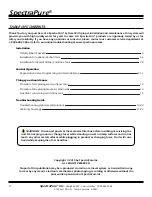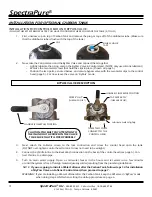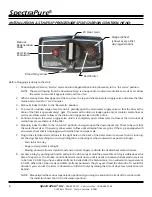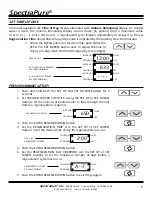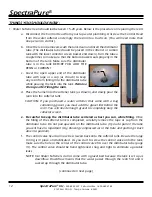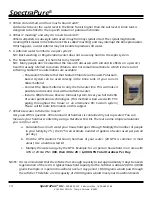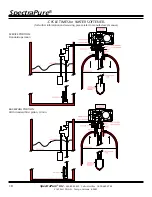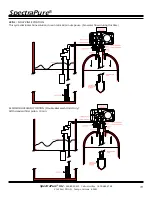
SpectraPure
®
SpectraPure
®
Inc.
480.894.5437 Call us toll-free 1.800.685.2783
2167 East Fifth St, Tempe, Arizona 85281
14
3. When do I add Salt, and how much should I add?:
Add salt whenever the water level in the Brine Tank is higher than the salt level. A brine tank is
designed to be filled to the top with sodium or potassium chloride.
4. What is “mushing” and why do I need to avoid it?:
When salt pellets or cube-style salt is used, it may form tiny crystals of salt. The crystals might bond,
creating thick masses in the brine tank. This is called “mushing” and may interrupt the brine production.
If this happens, a water softener may not be able to produce soft water.
5. Is softened water harmful to a septic system?:
NO. Back washing or Regeneration water does not cause any harm to the septic system.
6. The Sodium that is used, is it harmful to my health?:
NO. Many people don’t realized but the research discussed with salt and its effects on a person’s
health is usually referred to sodium chloride, and not sodium bicarbonate, which is the result of
softening. Sodium Free alternatives are available:
– Potassium Chloride rather that Sodium Chloride can be used. Potassium-
based crystals can be used directly in the brine tank of your current
Water Softener.
– Connect the Water Softener to only the hot water line. This will make it
possible to drink and cook with unsoftened water.
– Install a Whole House Reverse Osmosis System. Gives you full benefits
of water purification technologies. (This method is best used with PVC
piping throughout the house or an alternative RO Custom system)
Please call for more Information on this subject.
7. What size water softener do I need?:
Ask yourself this question.. What amount of hardness is contained in your tap water? You can
measure your hardness content by using a Hardness Test Kit. There are some simple calculations
you can do as well:
a. Calculate how much water your household goes through: Multiply the number of people
in your family by 75. ( the #75 is an estimate number of gallons of water used per person
per day.)
b. Find the GPG (Gallons Per Grain) hardness of your water. (20 GPG is common in most
areas). Use a hardness test kit.
c. Multiply the water usage by the GPG. Example: for a 4 person household, in an area with
GPG of 20:
4 x 75 = 300, then 300 x 20 = 6,000 GPG Total Hardness Per Day
.
NOTE: It is recommended that the softener has enough capacity to last approximately 3 days between
regeneration of the resin. A typical household capacity for the Softener is about 20,000 -40,000
grains. Example: A 4 -person household, over a 3 day period, 18,000 grains would pass through
the softener. Therefore a resin capacity of 20,000 grains would meet your household needs.


